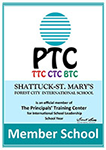Our History
A Short History of Shattuck-St. Mary’s

On June 3, 1858, in a small rented building in Faribault, Minnesota, USA, The Rev. Dr. James Lloyd Breck established the Episcopal mission school and seminary from which Shattuck-St. Mary’s School has developed and prospered. The Episcopal Church is the United States-based member church of the worldwide Anglican Communion. When the school first opened, there were 45 young girls and boys and six divinity students, both Native American and white.
About this time, the newly established Episcopal diocese of Minnesota selected Henry Benjamin Whipple as its first Bishop. Bishop Whipple established his home in Faribault and, in 1860, took over the reins of the school, changing Breck’s ambitious plan for “Bishop Seabury University” into something more realistic—”an honest school.”
In 1864, when Seabury Hall was completed, the school moved to its present site on the bluffs above the Straight River in Faribault. With this change, the institution became a boarding school for young men and boys. In 1865, Tommy Crump, an English divinity student recently returned from the American Civil War, started the boys drilling with sticks—and so began a military program that would last here for more than a century.
By 1866, more room was needed and, through the generosity of Dr. George Cheyne Shattuck of Boston, Shattuck Hall was built specifically for the boys. Soon the grammar school became known simply as “Shattuck.” That same year, Bishop Whipple opened a school for girls, St. Mary’s Hall, in his home in downtown Faribault. The girls remained there until 1872 when the Bishop moved to a new house and St. Mary’s Hall was turned over to a board of trustees. Also in 1872, the Chapel of the Good Shepherd was built through the generosity of Augusta Shumway of Chicago. Though she lost all her property in the great Chicago Fire, she kept her promise to build a chapel for “the Bishop’s boys’ school” by sending Whipple her insurance checks. With its rare, all-stone spire, it became the focal point of the Shattuck campus.
By 1883, St. Mary’s had outgrown its facilities, and a grand, ornate building, often referred to as “the Castle on the Rhine,” was built on the bluffs, less than a half mile south of Shattuck. That unique building burned in 1924, and the limestone structure that stands today was built less than a year later.
Both schools saw rapid growth during the next few years. Dr. James Dobbin, who had succeeded Dr. Breck in 1866 and who served as Rector of Shattuck School until 1914, was responsible for the construction of many beautiful limestone buildings, including the first Whipple Hall and the present Shumway Hall. In 1901, Dr. Dobbin founded St. James School for younger boys about a half mile north of Shattuck. In 1932, Seabury Theological Seminary merged with Western Theological Seminary and moved to Evanston, Illinois.
In 1972, the three schools, Shattuck, St. Mary’s and St. James, were joined into what is known today as Shattuck-St. Mary’s School. In 1974, the military program was discontinued.
In 1988, the residential and academic programs were reconfigured so that the Middle School students (grades 6-8) were at the St. Mary’s campus and the Upper School students (grades 9-12) were at the Shattuck Campus.

Bishop Whipple, c. 1864





